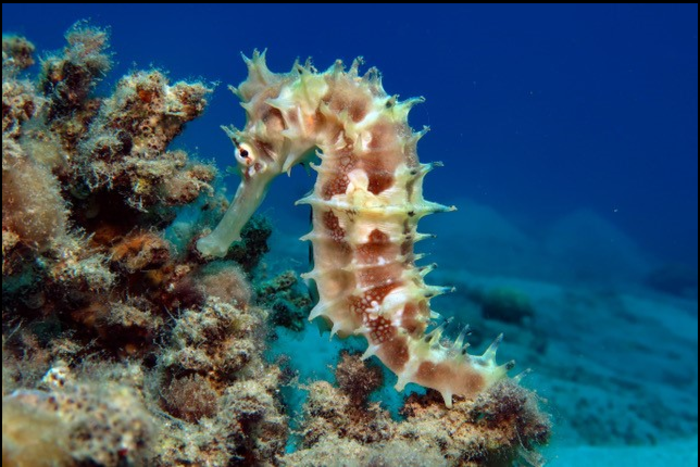Researchers at Tel Aviv University have discovered that seahorses can move their heads up at the extraordinary speed of 0.002 seconds when they were analyzing the unbelievable preying capability of seahorses. The fast head movement happens together with a robust flow of water that snags their prey straight into their mouth.
 A short-snouted seahorse clinging to coral in the Red Sea. Image Credit: Gil Koplovitz.
A short-snouted seahorse clinging to coral in the Red Sea. Image Credit: Gil Koplovitz.
The research was headed by Prof. Roi Holzman and the doctoral student Corrine Jacobs of the School of Zoology at the George S. Wise Faculty of Life Sciences and the Steinhardt Museum of Natural History at Tel Aviv University and was carried out at the Interuniversity Institute for Marine Sciences in Eilat. Details of the study have been published in the Journal of Experimental Biology.
The scientists describe that seahorses are fish that possess exclusive properties such as square tail vertebrae, male “pregnancy” and the undeniably exceptional eating system. During the day, seahorses tend to stay anchored with their tail to corals or seaweeds with their head tilted in a downward direction, close to their body. But when they spot prey moving over them, they lift their head at unbelievable speed and capture it.
According to Prof. Holzman, when seahorses prey, they turn their body like a spring: using their back muscles, they stretch an elastic tendon and utilize their neck bones as a “trigger,” similar to a crossbow. The outcome is faster than even the quickest muscle contraction seen anywhere in the animal kingdom.
However, so far it has not been clear how the spring-loaded contraction enabled seahorses to eat. Just like anyone who tries to remove a fly from a cup of tea understands, water is a viscous medium and the fish has to open its mouth to produce a flow that pulls the prey in. Now the question is, do seahorses synchronize snagging in prey using their head movement?
In their latest study, the Tel Aviv University scientists were successful in precisely describing and quantifying the movement of the seahorse by photographing their attack at a speed of 4,000 images per second and using a laser unit for imaging the water flows.
This measurement revealed that the “crossbow” system has twin purposes: allowing head movement and producing high-velocity suction currents — 10 times faster than the movement of fish of similar size. Their unique advantages allow seahorses to catch especially elusive prey.
The new measurements also help provide insights into the ecology of several species of seahorses, differentiated from each other by their nose size.
Our study shows that the speed of head movement and suction currents are determined by the length of a seahorse’s nose. From the evolutionary aspect, seahorses must choose between a short nose for strong suction and moderate head raising, or a long nose for rapid head raising and weaker suction currents.
Prof. Roi Holzman, Study Lead, Tel Aviv University
“This choice, of course, corresponds to the available diet: long-nosed species catch smaller, quicker animals whereas short-nosed species catch heavier, more ponderous ones,” he added.
Prof. Holzman believes that seahorses are not the only example of the remarkable spring mechanism. In fact, seahorses are members of the Misfit Fish family, including species such as shrimpfish, alligator pipefish and flutemouths or cornetfish.
These fish are called that because of their odd shape which enables stretching their body into a spring. The big question applies to the evolution of the spring mechanism, how it was formed and when it developed. I hope our recent study will lead to further studies designed to help solve the riddle of spring fish.
Prof. Roi Holzman, Study Lead, Tel Aviv University
Journal Reference:
Knight, K (2021). Rearing seahorses trigger powerful gulps. Journal of Experimental Biology. doi.org/10.1242/jeb.243282.